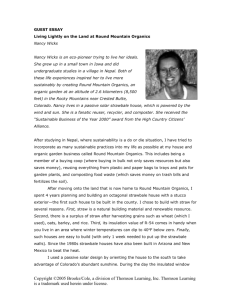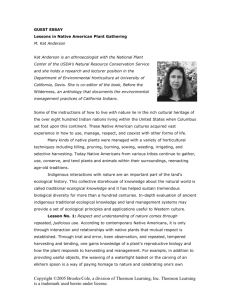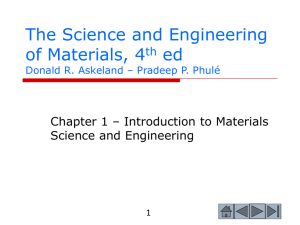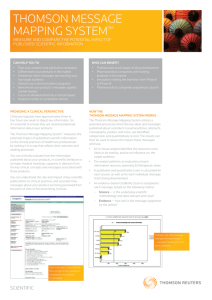The Science and Engineering of Materials, 4th ed Donald R
advertisement
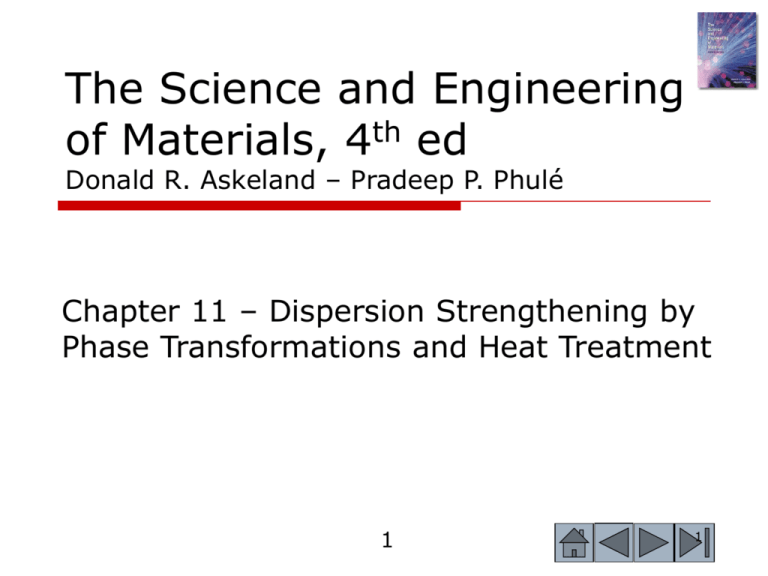
The Science and Engineering of Materials, 4th ed Donald R. Askeland – Pradeep P. Phulé Chapter 11 – Dispersion Strengthening by Phase Transformations and Heat Treatment 1 1 Objectives of Chapter 11 Discuss dispersion strengthening by studying a variety of solid-state transformation processes including precipitation or age hardening and the eutectoid reaction. Examine how nonequilibrium phase transformations—in particular, the martensitic reaction—can provide strengthening. 2 2 Chapter Outline 11.1 Nucleation and Growth in Solid-State Reactions 11.2 Alloys Strengthened by Exceeding the Solubility Limit 11.3 Age or Precipitation Hardening 11.4 Applications of Age-Hardened Alloys 11.5 Microstructural Evolution in Age or Precipitation Hardening 11.6 Effects of Aging Temperature and Time 3 3 Chapter Outline (Continued) 11.7 Requirements for Age Hardening 11.8 Use of Age-Hardenable Alloys at High Temperatures 11.9 The Eutectoid Reaction 11.10 Controlling the Eutectoid Reaction 11.11 The Martensitic Reaction and Tempering 11.12 The Shape-Memory Alloys (SMAs) 4 4 Section 11.1 Nucleation and Growth in Solid-State Reactions Strain energy - The energy required to permit a precipitate to fit into the surrounding matrix during nucleation and growth of the precipitate. Avrami relationship - Describes the fraction of a transformation that occurs as a function of time. This describes most solid-state transformations that involve diffusion, thus martensitic transformations are not described. 5 5 ©2003 Brooks/Cole, a division of Thomson Learning, Inc. Thomson Learning™ is a trademark used herein under license. Figure 11.1 Sigmoidal curve showing the rate of transformation of FCC iron at a constant temperature. The incubation time t0 and the time τ for the 50% transformation are also shown. 6 6 ©2003 Brooks/Cole, a division of Thomson Learning, Inc. Thomson Learning ™ is a trademark used herein under license. Figure 11.2 The effect of temperature on recrystallization of cold-worked copper. 7 7 ©2003 Brooks/Cole, a division of Thomson Learning, Inc. Thomson Learning™ is a trademark used herein under license. Figure 11.3 (a) The effect of temperature on the rate of a phase transformation is the product of the growth rate and nucleation rate contributions, giving a maximum transformation rate at a critical temperature. (b) Consequently, there is a minimum time (tmin) required for the transformation, given by the “C-curve”. 8 8 Example 11.1 Activation Energy for the Recrystallization of Copper Determine the activation energy for the recrystallization of copper from the sigmoidal curves in Figure 11.2. Figure 11.2 The effect of temperature on recrystallizati on of coldworked copper. 9 ©2003 Brooks/Cole, a division of Thomson Learning, Inc. Thomson Learning™ is a trademark used herein under license. 9 ©2003 Brooks/Cole, a division of Thomson Learning, Inc. Thomson Learning ™ is a trademark used herein under license. Figure 11.4 Arrhenius plot of transformation rate versus reciprocal temperature for recrystallization of copper (for Example 11.1. 10 10 Example 11.1 SOLUTION From Figure 11.2, the times required for 50% transformation at several different temperatures can be calculated: The rate of transformation is an Arrhenius equation, so a plot of ln (rate) versus 1/T (Figure 11.4 and Equation 11-4) allows us to calculate the constants in the equation. Taking natural log of both sides of Equation 11-4: ln(Growth rate) = ln A – (Q/RT) 11 11 Example 11.1 SOLUTION (Continued) Thus, if we plot ln(Growth rate) as a function of 1/T, we expect a straight line that has a slope of - Q/R. 12 12 Section 11.2 Alloys Strengthened by Exceeding the Solubility Limit Widmanstätten structure - The precipitation of a second phase from the matrix when there is a fixed crystallographic relationship between the precipitate and matrix crystal structures. Interfacial energy - The energy associated with the boundary between two phases. Dihedral angle - The angle that defines the shape of a precipitate particle in the matrix. Coherent precipitate - A precipitate whose crystal structure and atomic arrangement have a continuous relationship with the matrix from which the precipitate is formed. 13 13 ©2003 Brooks/Cole, a division of Thomson Learning, Inc. Thomson Learning ™ is a trademark used herein under license. Figure 11.5 The aluminum-copper phase diagram and the microstructures that may develop curing cooling of an Al-4% Cu alloy. 14 14 Figure 11.6 (a) Widmanstätten needles in a Cu-Ti alloy ( 420). (From ASM Handbook, Vol. 9, Metallography and Microstructure (1985), ASM International, Materials Park, OH 44073.) (b) Continuous θ precipitate in an Al-4% Cu alloy, caused by slow cooling ( 500). (c) Precipitates of lead at grain boundaries in copper ( 500). 15 15 ©2003 Brooks/Cole, a division of Thomson Learning, Inc. Thomson Learning ™ is a trademark used herein under license. Figure 11.7 The effect of surface energy and the dihedral angle on the shape of a precipitate. 16 16 ©2003 Brooks/Cole, a division of Thomson Learning, Inc. Thomson Learning™ is a trademark used herein under license. Figure 11.8 (a) A noncoherent precipitate has no relationship with the crystal structure of the surrounding matrix. (b) A coherent precipitate forms so that there is a definite relationship between the precipitate’s and the matrix’s crystal structure. 17 17 Section 11.3 Age or Precipitation Hardening Age hardening - A special dispersion-strengthening heat treatment. By solution treatment, quenching, and aging, a coherent precipitate forms that provides a substantial strengthening effect. Also known as precipitation hardening, it is a form of dispersion strengthening. 18 18 Section 11.4 Applications of Age-Hardened Alloys Figure 11.9 (a) A stress-strain curve showing the increase in strength of a bakehardenable steel as a result of strain hardening and precipitation hardening. (Source: U.S. Steel Corporation, Pittsburgh, PA.) 19 19 Figure 11.9 (b) A graph showing the increase in the yield strength of a bake hardenable steel (Source: Bethlehem Steel, PA.) (c) A TEM micrograph of a steel containing niobium (Nb) and manganese (Mn). The niobium react with carbon (C) and forms NbC precipitates that lead to strengthening. (Courtesy of Dr. A.J. Deardo, Dr. I. Garcia, Dr. M. Hua, University of Pittsburgh.) 20 20 Section 11.5 Microstructural Evolution in Age or Precipitation Hardening Step 1: Solution Treatment Step 2: Quench Step 3: Age Guinier-Preston (GP) zones - Tiny clusters of atoms that precipitate from the matrix in the early stages of the agehardening process. 21 21 ©2003 Brooks/Cole, a division of Thomson Learning, Inc. Thomson Learning™ is a trademark used herein under license. Figure 11.10 The aluminum-rich end of the aluminum-copper phase diagram showing the three steps in the age-hardening heat treatment and the microstructures that are produced. 22 22 Example 11.2 Composition of Al-4% Cu Alloy Phases Compare the composition of the a solid solution in the Al-4% Cu alloy at room temperature when the alloy cools under equilibrium conditions with that when the alloy is quenched. Figure 11.5 The aluminumcopper phase diagram and the microstructur es that may develop curing cooling of an Al-4% Cu alloy. ©2003 Brooks/Cole, a division of Thomson Learning, Inc. Thomson Learning™ is a trademark used herein under license. 23 23 Example 11.2 SOLUTION From Figure 11.5, a tie line can be drawn at room temperature. The composition of the α determined from the tie line is about 0.02% Cu. However, the composition of the α after quenching is still 4% Cu. Since α contains more than the equilibrium copper content, the α is supersaturated with copper. 24 24 Example 11.3 Design of an Age-Hardening Treatment The magnesium-aluminum phase diagram is shown in Figure 11.11. Suppose a Mg-8% Al alloy is responsive to an agehardening heat treatment. Design a heat treatment for the alloy. Figure 11.11 Portion of the aluminummagnesium phase diagram. ©2003 Brooks/Cole, a division of Thomson Learning, Inc. Thomson Learning ™ is a trademark used herein under license. 25 25 Example 11.3 SOLUTION Step 1: Solution-treat at a temperature between the solvus and the eutectic to avoid hot shortness. Thus, heat between 340oC and 451oC. Step 2: Quench to room temperature fast enough to prevent the precipitate phase β from forming. Step 3: Age at a temperature below the solvus, that is, below 340oC, to form a fine dispersion of β phase. 26 26 Figure 11.12 An electron micrograph of aged Al-15% Ag showing coherent g0 plates and round GP zones (40,000). (Courtesy of J.B. Clark.) 27 27 Section 11.6 Effects of Aging Temperature and Time Figure 11.13 The effect of aging temperature and time on the yield strength of an Al4% Cu alloy. ©2003 Brooks/Cole, a division of Thomson Learning, Inc. Thomson Learning™ is a trademark used herein under license. 28 28 Example 11.4 Effect of Aging Heat Treatment Time on the Strength of Aluminum Alloys The operator of a furnace left for his hour lunch break without removing the Al-4% Cu alloy from the furnace used for the aging treatment. Compare the effect on the yield strength of the extra hour of aging for the aging temperatures of 190oC and 260oC. Figure 11.13 The effect of aging temperature and time on the yield strength of an Al4% Cu alloy. ©2003 Brooks/Cole, a division of Thomson Learning, Inc. Thomson Learning™ is a trademark used herein under license. 29 29 Example 11.4 SOLUTION At 190oC, the peak strength of 400 MPa (60,000 psi) occurs at 2 h (Figure 11.13). After 3 h, the strength is essentially the same. At 260oC, the peak strength of 340 MPa (50,000 psi) occurs at 0.06 h. However, after 1 h, the strength decreases to 250 MPa (40,000 psi). Thus, the higher aging temperature gives lower peak strength and makes the strength more sensitive to aging time. 30 30 Section 11.7 Requirements for Age Hardening The alloy system must display decreasing solid solubility with decreasing temperature. The matrix should be relatively soft and ductile, and the precipitate should be hard and brittle. The alloy must be quenchable. A coherent precipitate must form. 31 31 Section 11.8 Use of Age-Hardenable Alloys at High Temperatures 32 32 ©2003 Brooks/Cole, a division of Thomson Learning, Inc. Thomson Learning ™ is a trademark used herein under license. Figure 11.14 Microstructural changes that occur in agehardened alloys during fusion welding: (a) microstructure in the weld at the peak temperature, and (b) microstructure in the weld after slowly cooling to room temperature. 33 33 Section 11.9 The Eutectoid Reaction Austenite - The name given to the FCC crystal structure of iron. Ferrite - The name given to the BCC crystal structure of iron that can occur as α or δ. Cementite - The hard, brittle ceramic-like compound Fe3C that, when properly dispersed, provides the strengthening in steels. Pearlite - A two-phase lamellar microconstituent, containing ferrite and cementite, that forms in steels cooled in a normal fashion or isothermally transformed at relatively high temperatures. 34 34 ©2003 Brooks/Cole, a division of Thomson Learning, Inc. Thomson Learning ™ is a trademark used herein under license. Figure 11.15 The FeFe3C phase diagram ( a portion of the Fe-C diagram). The vertical line at 6.67% C is the stoichiometric compound Fe3C. 35 35 Figure 11.16 Growth and structure of pearlite: (a) redistribution of carbon and iron, and (b) photomicrograph of the pearlite lamellae (2000). (From ASM Handbook, Vol. 7, (1972), ASM International, Materials Park, OH 44073.) 36 36 Example 11.5 Phases and Composition of Pearlite Calculate the amounts of ferrite and cementite present in pearlite. Example 11.5 SOLUTION Since pearlite must contain 0.77% C, using the lever rule: % 6.67 0.77 100 88.7% 6.67 0.0218 0 . 77 0 . 0218 %Fe3C 100 11.3% 6.67 0.0218 37 37 Example 11.6 Tungsten Carbide (WC)-Cobalt (Co) Composite and Pearlite Tungsten carbide-cobalt composites, known as cemented carbides or carbides, are used as bits for cutting tools and drills (Chapter 1). What features are similar between these ‘‘cemented carbides’’ and pearlite, a microconstituent in steels? What are some of the major differences? Example 11.6 SOLUTION In both materials, we take advantage of the toughness of one phase (ferrite or cobalt metal, in the case of pearlite in steel and WC-Co, respectively) and the hard ceramic like phase (WC and Fe3C, in WC-Co and steel, respectively). The metallic phase helps with ductility and the hard phase helps with strength. 38 38 Example 11.6 SOLUTION (Continued) The difference is, WC and Co are two separate compounds that are sintered together using the powder metallurgy route. Pearlite is a microconstituent made up of two phases derived from same two elements (Fe-C). Another difference is in pearlite, the phases are formed via a eutectoid reaction. No such reaction occurs in the formation of WC-Co composites. Typically, WC-Co microstructure consists mainly of WC grains that are ‘‘glued’’ by cobalt grains. In pearlite, the metal-like ferrite phase dominates. 39 39 ©2003 Brooks/Cole, a division of Thomson Learning, Inc. Thomson Learning™ is a trademark used herein under license. Figure 11.17 The evolution of the microstructure of hypoeutectoid and hypoeutectoid steels during cooling. In relationship to the Fe-Fe3C phase diagram. 40 40 Figure 11.18 (a) A hypoeutectoid steel showing primary α (white) and pearlite ( 400). (b) A hypereutectoid steel showing primary Fe3C surrounding pearlite ( 800). (From ASM Handbook, Vol. 7, (1972), ASM International, Materials Park, OH 44073.) 41 41 Example 11.7 Phases in Hypoeutectoid Plain Carbon Steel Calculate the amounts and compositions of phases and microconstituents in a Fe-0.60% C alloy at 726oC. Example 11.7 SOLUTION The phases are ferrite and cementite. Using a tie line and working the lever law at 726oC, we find: 6.67 0.60 (0.0218%C )% 100 91.3% 6.67 0.0218 0.60 0.0218 Fe3C (6.67%C )%Fe3C 100 8.7% 6.67 0.0218 42 42 Example 11.7 SOLUTION (Continued) All of the austenite at 727oC will have eutectoid composition (i.e., it will contain 0.77% C) and will transform to pearlite; all of the proeutectoid ferrite will remain as primary ferrite. Primary : 0.0218% C % Primary 0.77 0.60 6 . 67 0 . 0218 100 22.7% Austentite just above 727o C Pearlite : 0.77% C 0.60 - 0.0218 % Pearlite 100 77.3% 6 . 67 0 . 0218 43 43 Section 11.10 Controlling the Eutectoid Reaction Controlling the Amount of the Eutectoid Controlling the Austenite Grain Size Controlling the Cooling Rate Controlling the Transformation Temperature TTT diagram - The time-temperature-transformation diagram describes the time required at any temperature for a phase transformation to begin and end. Isothermal transformation - When the amount of a transformation at a particular temperature depends on the time permitted for the transformation. 44 44 45 45 ©2003 Brooks/Cole, a division of Thomson Learning, Inc. Thomson Learning ™ is a trademark used herein under license. Figure 11.19 The effect of interlamellar spacing (λ) of on the yield strength of pearlite. 46 46 ©2003 Brooks/Cole, a division of Thomson Learning, Inc. Thomson Learning™ is a trademark used herein under license. Figure 11.20 The effect of the austenite transformation temperature on the interlamellar spacing of pearlite. 47 47 ©2003 Brooks/Cole, a division of Thomson Learning, Inc. Thomson Learning ™ is a trademark used herein under license. Figure 11.21 The time-temperature-transformation (TTT) diagram for an eutectoid steel. 48 48 ©2003 Brooks/Cole, a division of Thomson Learning, Inc. Thomson Learning™ is a trademark used herein under license. Figure 11.22 The sigmoidal curve is related to the start and finish times on the TTT diagram for steel. In this case, austenite is transforming to pearlite. 49 49 Figure 11.23 (a) Upper bainite (gray, feathery plates) ( 600). (b) Lower bainite (dark needles) ( 400). (From ASM Handbook, Vol. 8, (1973), ASM International, Materials Park, OH 44073.) 50 50 ©2003 Brooks/Cole, a division of Thomson Learning, Inc. Thomson Learning™ is a trademark used herein under license. Figure 11.24 The effect of transformation temperature on the properties of an eutectoid steel. 51 51 Example 11.8 Design of a Heat Treatment to Generate Pearlite Microstructure Design a heat treatment to produce the pearlite structure shown in Figure 11.16(b). Figure 11.16 Growth and structure of pearlite: (b) photomicrograph of the pearlite lamellae ( 2000). (From ASM Handbook, Vol. 7, (1972), ASM International, Materials Park, OH 44073.) 52 52 Example 11.8 (Continued) ©2003 Brooks/Cole, a division of Thomson Learning, Inc. Thomson Learning ™ is a trademark used herein under license. Figure 11.21 The time-temperature-transformation (TTT) diagram for an eutectoid steel. 53 53 Example 11.8 SOLUTION Interlamellar spacing of the pearlite: If we assume that the pearlite is formed by an isothermal transformation, we find from Figure 11.20 that the transformation temperature must have been approximately 700oC. From the TTT diagram (Figure 11.21), our heat treatment must have been: 1. Heat the steel to about 750oC and hold—perhaps for 1 h—to produce all austenite. A higher temperature may cause excessive growth of austenite grains. 2. Quench to 700oC and hold for at least 105 s (the Pf time). 3. Cool to room temperature. 54 54 Example 11.9 Heat Treatment to Generate Bainite Microstructure Excellent combinations of hardness, strength, and toughness are obtained from bainite. One heat treatment facility austenitized an eutectoid steel at 750oC, quenched and held the steel at 250oC for 15 min, and finally permitted the steel to cool to room temperature. Was the required bainitic structure produced? 55 55 ©2003 Brooks/Cole, a division of Thomson Learning, Inc. Thomson Learning™ is a trademark used herein under license. Figure 11.21 The time-temperature-transformation (TTT) diagram for an eutectoid steel. 56 56 Example 11.9 SOLUTION After heating at 750oC, the microstructure is 100% γ. After quenching to 250oC, unstable austenite remains for slightly more than 100 s, when fine bainite begins to grow. After 15 min, or 900 s, about 50% fine bainite has formed and the remainder of the steel still contains unstable austenite. The heat treatment was not successful! The heat treatment facility should have held the steel at 250oC for at least 104 s, or about 3 h. 57 57 Section 11.11 The Martensitic Reaction and Tempering Martensite - A metastable phase formed in steel and other materials by a diffusionless, athermal transformation. Displacive transformation - A phase transformation that occurs via small displacements of atoms or ions and without diffusion. Same as athermal or martensitic transformation. Tempering - A low-temperature heat treatment used to reduce the hardness of martensite by permitting the martensite to begin to decompose to the equilibrium phases. 58 58 ©2003 Brooks/Cole, a division of Thomson Learning, Inc. Thomson Learning ™ is a trademark used herein under license. Figure 11.25 (a) The unit cell of BCT martensite is related to the FCC austenite unit cell. (b) As the percentage of carbon increases, more interstitial sites are filled by the carbon atoms and the tetragonal structure of the martensite becomes more pronounced. 59 59 Example 11.10 Design of a Heat Treatment for a Dual Phase Steel Unusual combinations of properties can be obtained by producing a steel whose microstructure contains 50% ferrite and 50% martensite; the martensite provides strength and the ferrite provides ductility and toughness. Design a heat treatment to produce a dual phase steel in which the composition of the martensite is 0.60% C. 60 60 Example 11.10 SOLUTION The heat treatment temperature is fixed by the requirement that the martensite contain 0.60% C. From the solubility line between the γ and the α + γ regions, we find that 0.60% C is obtained in austenite when the temperature is about 750oC. To produce 50% martensite, we need to select a steel that gives 50% austenite when the steel is held at 750oC. If the carbon content of the steel is x, then: (x 0.02) 100 50 or x 0.31% C % (0.60 0.02 Our final design is: 1. Select a hypoeutectoid steel containing 0.31% C. 2. Heat the steel to 750oC and hold (perhaps for 1 h, depending on the thickness of the part) to produce a structure containing 50% ferrite and 50% austenite, with 0.60% C in the austenite. 3. Quench the steel to room temperature. The austenite transforms to martensite, also containing 0.60% C. 61 61 ©2003 Brooks/Cole, a division of Thomson Learning, Inc. Thomson Learning™ is a trademark used herein under license. Figure 11.26 The effect of carbon content on the hardness of martensite in steels. 62 62 Figure 11.27 (a) Lath martensite in low-carbon steel ( 80). (b) Plate martensite in high-carbon steel ( 400). (From ASM Handbook, Vol. 8, (1973), ASM International, Materials Park, OH 44073.) 63 63 ©2003 Brooks/Cole, a division of Thomson Learning, Inc. Thomson Learning ™ is a trademark used herein under license. Figure 11.28 Effect of tempering temperature on the properties of and eutectoid steel. 64 64 Figure 11.29 Tempered martensite in steel ( 500). (From ASM Handbook, Vol. 9, Metallography and Microstructure (1985), ASM International Materials Park, OH 44073.) 65 65 Section 11.12 The Shape-Memory Alloys (SMAs) Shape-memory effect -The ability of certain materials to develop microstructures that, after being deformed, can return the material to its initial shape when heated (e.g. Ni-Ti alloys). Smart materials - Materials that can sense an external stimulus (e.g., stress, pressure, temperature change, magnetic field, etc.) and initiate a response. Passively smart materials can sense external stimulus, actively smart materials have sensing and actuation capabilities. 66 66 Example 11.11 Design of a Coupling for Tubing At times, you need to join titanium tubing in the field. Design a method for doing this quickly. ©2003 Brooks/Cole, a division of Thomson Learning, Inc. Thomson Learning™ is a trademark used herein under license. 67 Figure 11.30 Use of memory alloys for coupling tubing: A memory alloy coupling is expanded (a) so it fits over the tubing (b). When the coupling is reheated, it shrinks back to its original diameter (c), squeezing the tubing for a tight fit (for Example 11.11). 67 Example 11.11 SOLUTION We can take advantage of the shape-memory effect for this application (Figure 11.30). Ahead of time, we can set a Ni-Ti coupling into a small diameter, then deform it into a larger diameter in the martensitic state. In the field, the coupling, which is in the martensitic state, is slipped over the tubing and heated above Af (at a low enough temperature so that the titanium tubing is not contaminated). The coupling contracts back to its predetermined shape as a result of the shape-memory effect, producing a strong mechanical bond to join the tubes. 68 68 Example 11.12 Selection of Material for a Self-Expandable Cardiovascular Stent Close to a half million people in the world have coronary stents. These are mostly made from 316 stainless steel, but some are made from platinum. How would you go about designing a material for making a cardiovascular stent?[15] A conventional stent is essentially a slotted tube that is inserted into an artery. This procedure is typically done by doctors after a procedure known as an angioplasty is conducted. 69 69 Example 11.12 SOLUTION We can consider using Ni-Ti shape-memory alloys. Currently, the cardiovascular stents are made mostly from 316 stainless steel. A number of issues such as the use of a nonmagnetic material, biocompatibility, corrosion resistance, mechanical properties, and durability must be considered carefully, especially for biomedical applications. Most likely, the cost of the material or stent would also play a small part in the total cost of the procedure. 70 70 ©2003 Brooks/Cole, a division of Thomson Learning, Inc. Thomson Learning™ is a trademark used herein under license. Figure 11.31 The effect of temperature on the crystallization of polypropylene (for Problems 11.2, 11.4, and 11.106). 71 71 ©2003 Brooks/Cole, a division of Thomson Learning, Inc. Thomson Learning™ is a trademark used herein under license. Figure 11.32 Hypothetical phase diagram (for Problem 11.38). 72 72 ©2003 Brooks/Cole, a division of Thomson Learning, Inc. Thomson Learning ™ is a trademark used herein under license. Figure 11.33 The Zr02-Ca0 phase diagram. A polymorphic phase transformation occurs for pure Zr02. Adding 16 to 26% Ca0 produces a single cubic zirconia phase at all temperatures (for Problem 11.62). 73 73 ©2003 Brooks/Cole, a division of Thomson Learning, Inc. Thomson Learning™ is a trademark used herein under license. Figure 11.34 Binary phase diagrams for the (a) copper-zinc, (b) copper-tin, (c) copper-aluminum, and (d) copperberrylium systems (for Problems 11.16 and 11.62). 74 74 ©2003 Brooks/Cole, a division of Thomson Learning, Inc. Thomson Learning™ is a trademark used herein under license. Figure 11.35 The eutectoid portion of the Fe-Fe3C phase diagram (for Problems 11.78, 11.86, 11.87, and 11.88) 75 75 ©2003 Brooks/Cole, a division of Thomson Learning, Inc. Thomson Learning ™ is a trademark used herein under license. Figure 11.36 The effect of temperature on the crystallization of polypropylene (for Problems 11.4 and 11.106). 76 76



